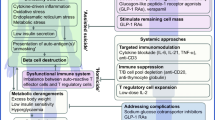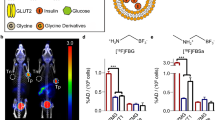Abstract
Type 1 diabetes is caused by death of insulin-producing pancreatic beta cells. Beta-cell apoptosis induced by FasL may be important in type 1 diabetes in humans and in the non-obese diabetic (NOD) mouse model. Deficiency of the pro-apoptotic BH3-only molecule Bid protects beta cells from FasL-induced apoptosis in vitro. We aimed to test the requirement for Bid, and the significance of Bid-dependent FasL-induced beta-cell apoptosis in type 1 diabetes. We backcrossed Bid-deficient mice, produced by homologous recombination and thus without transgene overexpression, onto a NOD genetic background. Genome-wide single nucleotide polymorphism analysis demonstrated that diabetes-related genetic regions were NOD genotype. Transferred beta cell antigen-specific CD8+ T cells proliferated normally in the pancreatic lymph nodes of Bid-deficient mice. Moreover, Bid-deficient NOD mice developed type 1 diabetes and insulitis similarly to wild-type NOD mice. Our data indicate that beta-cell apoptosis in type 1 diabetes can proceed without Fas-induced killing mediated by the BH3-only protein Bid.




Similar content being viewed by others
References
Thomas HE, McKenzie MD, Angstetra E, Campbell PD, Kay TW (2009) Beta cell apoptosis in diabetes. Apoptosis 14:1389–1404
Amrani A, Verdaguer J, Anderson B, Utsugi T, Bou S, Santamaria P (1999) Perforin-independent beta-cell destruction by diabetogenic CD8(+) T lymphocytes in transgenic nonobese diabetic mice. J Clin Invest 103:1201–1209
Dudek NL, Thomas HE, Mariana L, Sutherland RM, Allison J, Estella E, Angstetra E, Trapani JA, Santamaria P, Lew AM, Kay TW (2006) Cytotoxic T-cells from T-cell receptor transgenic NOD8.3 mice destroy beta-cells via the perforin and Fas pathways. Diabetes 55:2412–2418
Kreuwel HT, Morgan DJ, Krahl T, Ko A, Sarvetnick N, Sherman LA (1999) Comparing the relative role of perforin/granzyme versus Fas/Fas ligand cytotoxic pathways in CD8+ T cell-mediated insulin-dependent diabetes mellitus. J Immunol 163:4335–4341
McKenzie MD, Dudek NL, Mariana L, Chong MM, Trapani JA, Kay TW, Thomas HE (2006) Perforin and Fas induced by IFNgamma and TNFalpha mediate beta cell death by OT-I CTL. Int Immunol 18:837–846
Thomas HE, Darwiche R, Corbett JA, Kay TW (1999) Evidence that beta cell death in the nonobese diabetic mouse is Fas independent. J Immunol 163:1562–1569
Moriwaki M, Itoh N, Miyagawa J, Yamamoto K, Imagawa A, Yamagata K, Iwahashi H, Nakajima H, Namba M, Nagata S, Hanafusa T, Matsuzawa Y (1999) Fas and Fas ligand expression in inflamed islets in pancreas sections of patients with recent-onset Type I diabetes mellitus. Diabetologia 42:1332–1340
Darwiche R, Chong MM, Santamaria P, Thomas HE, Kay TW (2003) Fas is detectable on beta cells in accelerated, but not spontaneous, diabetes in nonobese diabetic mice. J Immunol 170:6292–6297
Allison J, Strasser A (1998) Mechanisms of beta cell death in diabetes: a minor role for CD95. Proc Natl Acad Sci USA 95:13818–13822
Chervonsky AV, Wang Y, Wong FS, Visintin I, Flavell RA, Janeway CA Jr, Matis LA (1997) The role of Fas in autoimmune diabetes. Cell 89:17–24
Itoh N, Imagawa A, Hanafusa T, Waguri M, Yamamoto K, Iwahashi H, Moriwaki M, Nakajima H, Miyagawa J, Namba M, Makino S, Nagata S, Kono N, Matsuzawa Y (1997) Requirement of Fas for the development of autoimmune diabetes in nonobese diabetic mice. J Exp Med 186:613–618
Mohamood AS, Guler ML, Xiao Z, Zheng D, Hess A, Wang Y, Yagita H, Schneck JP, Hamad AR (2007) Protection from autoimmune diabetes and T-cell lymphoproliferation induced by FasL mutation are differentially regulated and can be uncoupled pharmacologically. Am J Pathol 171:97–106
Nakayama M, Nagata M, Yasuda H, Arisawa K, Kotani R, Yamada K, Chowdhury SA, Chakrabarty S, Jin ZZ, Yagita H, Yokono K, Kasuga M (2002) Fas/Fas ligand interactions play an essential role in the initiation of murine autoimmune diabetes. Diabetes 51:1391–1397
Suarez-Pinzon WL, Power RF, Rabinovitch A (2000) Fas ligand-mediated mechanisms are involved in autoimmune destruction of islet beta cells in non-obese diabetic mice. Diabetologia 43:1149–1156
Vence L, Benoist C, Mathis D (2004) Fas deficiency prevents type 1 diabetes by inducing hyporesponsiveness in islet beta-cell-reactive T-cells. Diabetes 53:2797–2803
Allison J, Thomas HE, Catterall T, Kay TW, Strasser A (2005) Transgenic expression of dominant-negative Fas-associated death domain protein in beta cells protects against Fas ligand-induced apoptosis and reduces spontaneous diabetes in nonobese diabetic mice. J Immunol 175:293–301
Hugues S, Mougneau E, Ferlin W, Jeske D, Hofman P, Homann D, Beaudoin L, Schrike C, Von Herrath M, Lehuen A, Glaichenhaus N (2002) Tolerance to islet antigens and prevention from diabetes induced by limited apoptosis of pancreatic beta cells. Immunity 16:169–181
Millet I, Wong FS, Gurr W, Wen L, Zawalich W, Green EA, Flavell RA, Sherwin RS (2006) Targeted expression of the anti-apoptotic gene CrmA to NOD pancreatic islets protects from autoimmune diabetes. J Autoimmun 26:7–15
Savinov AY, Tcherepanov A, Green EA, Flavell RA, Chervonsky AV (2003) Contribution of Fas to diabetes development. Proc Natl Acad Sci USA 100:628–632
Apostolou I, Hao Z, Rajewsky K, von Boehmer H (2003) Effective destruction of Fas-deficient insulin-producing beta cells in type 1 diabetes. J Exp Med 198:1103–1106
Leiter EH, Reifsnyder P, Driver J, Kamdar S, Choisy-Rossi C, Serreze DV, Hara M, Chervonsky A (2007) Unexpected functional consequences of xenogeneic transgene expression in beta-cells of NOD mice. Diabetes Obes Metab 9(Suppl 2):14–22
Lee JY, Ristow M, Lin X, White MF, Magnuson MA, Hennighausen L (2006) RIP-Cre revisited, evidence for impairments of pancreatic beta-cell function. J Biol Chem 281:2649–2653
Pomplun D, Florian S, Schulz T, Pfeiffer AF, Ristow M (2007) Alterations of pancreatic beta-cell mass and islet number due to Ins2-controlled expression of Cre recombinase: RIP-Cre revisited; part 2. Horm Metab Res 39:336–340
McKenzie MD, Carrington EM, Kaufmann T, Strasser A, Huang DC, Kay TW, Allison J, Thomas HE (2008) Proapoptotic BH3-only protein Bid is essential for death receptor-induced apoptosis of pancreatic beta-cells. Diabetes 57:1284–1292
Kaufmann T, Tai L, Ekert PG, Huang DC, Norris F, Lindemann RK, Johnstone RW, Dixit VM, Strasser A (2007) The BH3-only protein bid is dispensable for DNA damage- and replicative stress-induced apoptosis or cell-cycle arrest. Cell 129:423–433
Verdaguer J, Schmidt D, Amrani A, Anderson B, Averill N, Santamaria P (1997) Spontaneous autoimmune diabetes in monoclonal T cell nonobese diabetic mice. J Exp Med 186:1663–1676
Ghosh S, Palmer SM, Rodrigues NR, Cordell HJ, Hearne CM, Cornall RJ, Prins JB, McShane P, Lathrop GM, Peterson LB et al (1993) Polygenic control of autoimmune diabetes in nonobese diabetic mice. Nat Genet 4:404–409
Rogner UC, Boitard C, Morin J, Melanitou E, Avner P (2001) Three loci on mouse chromosome 6 influence onset and final incidence of type I diabetes in NOD.C3H congenic strains. Genomics 74:163–171
Krishnamurthy B, Dudek NL, McKenzie MD, Purcell AW, Brooks AG, Gellert S, Colman PG, Harrison LC, Lew AM, Thomas HE, Kay TW (2006) Responses against islet antigens in NOD mice are prevented by tolerance to proinsulin but not IGRP. J Clin Invest 116:3258–3265
Lieberman SM, Takaki T, Han B, Santamaria P, Serreze DV, DiLorenzo TP (2004) Individual nonobese diabetic mice exhibit unique patterns of CD8+ T cell reactivity to three islet antigens, including the newly identified widely expressed dystrophia myotonica kinase. J Immunol 173:6727–6734
Yin XM, Wang K, Gross A, Zhao Y, Zinkel S, Klocke B, Roth KA, Korsmeyer SJ (1999) Bid-deficient mice are resistant to Fas-induced hepatocellular apoptosis. Nature 400:886–891
Kagi D, Odermatt B, Seiler P, Zinkernagel RM, Mak TW, Hengartner H (1997) Reduced incidence and delayed onset of diabetes in perforin-deficient nonobese diabetic mice. J Exp Med 186:989–997
Suarez-Pinzon WL, Szabo C, Rabinovitch A (1997) Development of autoimmune diabetes in NOD mice is associated with the formation of peroxynitrite in pancreatic islet beta-cells. Diabetes 46:907–911
Vandenabeele P, Galluzzi L, Vanden Berghe T, Kroemer G (2010) Molecular mechanisms of necroptosis: an ordered cellular explosion. Nat Rev Mol Cell Biol 11:700–714
Jung HS, Chung KW, Won Kim J, Kim J, Komatsu M, Tanaka K, Nguyen YH, Kang TM, Yoon KH, Kim JW, Jeong YT, Han MS, Lee MK, Kim KW, Shin J, Lee MS (2008) Loss of autophagy diminishes pancreatic beta cell mass and function with resultant hyperglycemia. Cell Metab 8:318–324
Choi D, Radziszewska A, Schroer SA, Liadis N, Liu Y, Zhang Y, Lam PP, Sheu L, Hao Z, Gaisano HY, Woo M (2009) Deletion of Fas in the pancreatic beta-cells leads to enhanced insulin secretion. Am J Physiol Endocrinol Metab 297:E1304–E1312
Schumann DM, Maedler K, Franklin I, Konrad D, Storling J, Boni-Schnetzler M, Gjinovci A, Kurrer MO, Gauthier BR, Bosco D, Andres A, Berney T, Greter M, Becher B, Chervonsky AV, Halban PA, Mandrup-Poulsen T, Wollheim CB, Donath MY (2007) The Fas pathway is involved in pancreatic beta cell secretory function. Proc Natl Acad Sci USA 104:2861–2866
Acknowledgments
We thank Jonathan Chee, Cameron Kos and Lorraine Elkerbout for technical assistance. This study was supported by a grants and fellowships from the National Health and Medical Research Council of Australia, the Juvenile Diabetes Research Foundation, the Leukemia and Lymphoma Society of America and the NIH. P.S. is supported by the Canadian Institutes of Health Research and the Natural Sciences and Engineering Research Council of Canada and is a Scientist of Alberta Innovates-Health Solutions.
Conflict of interest
None.
Author information
Authors and Affiliations
Corresponding author
Rights and permissions
About this article
Cite this article
Mollah, Z.U.A., Wali, J., McKenzie, M.D. et al. The pro-apoptotic BH3-only protein Bid is dispensable for development of insulitis and diabetes in the non-obese diabetic mouse. Apoptosis 16, 822–830 (2011). https://doi.org/10.1007/s10495-011-0615-z
Published:
Issue Date:
DOI: https://doi.org/10.1007/s10495-011-0615-z




